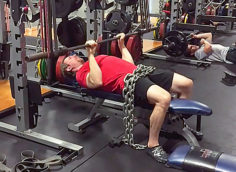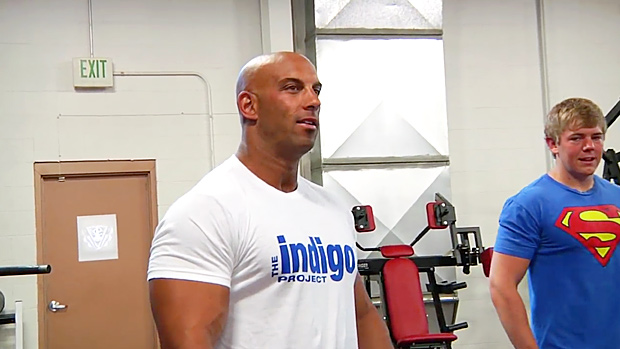There's no shortage of good programs designed to help you get stronger. There are also some good programs aimed at helping you induce hypertrophy and get your grow on. UnfortunateAly, you're usually left to choose between these two goals, or at least severely compromise one of them while focusing on the other.
Well, I decided to try to solve this dilemma. I put my thinking cap on and designed a program specifically for those of us who want to get bigger and stronger at the same time.
Blending Size and Strength, Version 2.0 is the unparalleled, the supreme, the incomparable, simply the most badass program ever developed. This program will make all hypertrophy and strength-inducing programs obsolete! You'll never do, or need, another training program... at least until version 3.0 is released.
Come on, now! I hope you didn't think I was serious. I wouldn't try to blow sunshine up your skirt like that. While the above paragraph is complete crap, Blending Size and Strength, Version 2.0 really is a good, solid program that works for the vast majority of people who diligently follow it.
Conventional training wisdom tells us that training for size and training for strength are two separate entities. Just take a look at the routines of the top powerlifters and top bodybuilders. They differ like night and day. So how do we solve this riddle of wanting to get big and strong simultaneously?
Heavy weight and low reps (1-5) are the undisputed king for producing maximal gains in strength. The key here is that high amounts of tension are placed on the muscle. High levels of tension are synonymous with strength gains.
Getting experts to agree on exactly what's best for inducing hypertrophy is a bit more tricky. However, it's fairly well accepted that somewhere between 10 and 20 reps work best for delivering skin-stretching gains in size.
This is assuming that there are a significant number of sets to accompany these reps. It's safe to say that the cornerstone of hypertrophy training is to put the muscles through a high volume of training.
But let's not forget the 6-10 repetition range. Conventional experts say this is a good rep range to use when you want to get stronger and bigger. But the fact of the matter is this: if you were to only do 6-10 reps for all your sets, you would likely get a bit bigger and a bit stronger.
However, you'd be severely limiting the levels of strength and hypertrophy that you could've ultimately attained if you'd included other rep ranges too. The 6-10 rep range is great, but it isn't a cure-all like many gym-goers seem to think.

Some try to solve this problem with routines that have utilized periodization. They have you train with heavy loads for a few weeks in order to maximize strength. Then they'll have you switch gears for a few weeks and do training designed for hypertrophy.
One thing I don't like about that approach is that strength tends to wane during the hypertrophy phase, and gains in size often slow down during the strength-only. On top of that, you have to wait many weeks (through at least one phase of each cycle) to make decent progress in both realms. Call me impatient, but I want to improve both at the same time.
To appease my impatience, and that of my clients, I designed this program. It includes high levels of tension to optimize strength, like any good powerlifting program would. It also uses higher volume and more reps to maximize size gains, like most hypertrophy-producing workouts would.

Both of these parameters are covered each week, so you'll quickly be on your way to achieving both goals. The program is elegantly simple, but don't let that fool you. The results you'll achieve in strength and size will surprise you.
To get downright strong, you're going to train each bodypart with one heavy, low-rep day per week. To get your swole on, you're going to train each bodypart with one light, high-rep day per week.
That's right... you're training each bodypart twice a week. Not three times, as with most full body workouts. Not once a week, as is the norm for so many pure bodybuilding workouts. But two times each week.
This frequency, and the varied stimuli with each workout, gives you the best of both worlds. That's exactly what I set out to do, give you a great strength-inducing workout and a great size-producing workout, all in one neat little package.
Monday: Heavy Upper Body
| Exercise | Sets | Reps | |
|---|---|---|---|
| A1 | Barbell Bench Press | 6 | 3 |
| A2 | T-bar Row | 6 | 3 |
| B1 | Standing Barbell Shoulder Press | 5 | 5 |
| B2 | Pull-Up | 5 | 5 |
| C1 | Skullcrusher | 3 | 5 |
| C2 | Barbell Curl | 3 | 5 |
Workout Notes
- Rest two to three minutes between sets of the same exercise.
- Keep your elbows from flaring way out to the sides on the bench press.
- Use the wide horizontal handles on the T-bar row. Your grip width should be about the same used in the bench press.
- Feel free to use your legs to spot you, like a push press, on the last rep or two of the shoulder press.
- You may use an assisted pull-up machine, bands, or a spot from a friend if you're not yet strong enough to do pull-ups with your bodyweight. Do pulldowns only as a last resort.
Tuesday: Light Lower Body and Abs
| Exercise | Sets | Reps | |
|---|---|---|---|
| A | Unilateral Leg Press | 3 | 25/20/15 |
| B | Dumbbell Stiff leg Deadlift | 3 | 12-15 |
| C | Barbell Walking Lunge | 2 | 30 |
| D | Seated Calf Raise | 3 | 20 |
| E | Crunch | 3 | failure |
Workout Notes
- Rest 60 seconds between sets.
- Rest 15-30 seconds between each leg on the leg press.
- Consciously utilize your glutes when coming up in the stiff leg deadlift. Go up until your torso is about 15 degrees from vertical to keep tension on the targeted muscles.
- Take long strides in the walking lunge for a total of 30 steps/reps (15 each leg) per set.
- Add weight to the crunches, if needed, to keep the reps under 25.
Wednesday: Off
Thursday: Light Upper Body
| Exercise | Sets | Reps | |
|---|---|---|---|
| A1 | Decline Dumbbell Bench Press | 3 | 15/12/20 |
| A2 | Dumbbell Row | 3 | 15/12/20 |
| B1 | Dumbbell Lateral Raise | 3 | 15 |
| B2 | Pulldown to the front | 3 | 15 |
| C1 | Preacher Curl | 2 | 15 |
| C2 | Overhead Unilateral Dumbbell Extension | 2 | 15 |
Workout Notes
- As with Tuesday's "light" workout, the rest intervals today should be 60 seconds.
- Avoid shrugging your shoulders when doing lateral raises. Make sure to keep the dumbbells level at the top, avoiding the tendency for the pinky to go down and the thumb to go up.
- On dumbbell extensions, avoid locking out at the top, which would take tension off the triceps. Make sure to lower the dumbbell until your forearm is parallel to the ground, with about a 70 degree bend in your elbow.
Friday: Heavy Lower Body and Abs
| Exercise | Sets | Reps | |
|---|---|---|---|
| A | Barbell Squat | 6 | 4 |
| B | Rack Deadlift | 4 | 8/6/4/2 |
| C | Lying Leg Curl | 3 | 6 |
| D | Standing Calf Raise | 5 | 5 |
| E | Hanging Leg Raise | 3 | 8 |
Workout Notes
- Rest intervals should be two to three minutes, more for squats if needed.
- Be a real man and squat deep! If you are going to do a crappy-ass half squat, don't tell anyone you're doing my program.
- On rack deads, set the pin so that you're starting three or four inches below the knee, just below the tibial tuberosity (that bump just below your kneecap.)
- Retract your scapulae at the top of the deadlift.
- Keep your feet plantar flexed (pointed down) when doing leg curls.
- Do a real hanging leg raise by raising your feet up to your hands, tucking your tailbone under, and really tilting your pelvis posteriorly. Don't just flex your hips and raise your knees up.
Saturday and Sunday : Off
The number of sets listed does not include warm-up sets. Make sure to warm-up properly, but avoid fatiguing yourself too much before your work sets. One or two light sets will do the trick, especially if you've done some mobility work before getting started.
To reduce the risk of overtraining, you'll only train four days per week. To further reduce the risk of overdoing it, make sure to not do any forced repetitions. On the heavy day, you should be able to complete your last rep with good form and not have enough left for another rep.
On the light day, stop a rep or two short of failure. Holding back from going absolutely all out is something that's tough for me to do, and it may be for you, too. But your patience will pay off with steady muscle gains.
One of the most important, yet simplest, ways to ensure your steady progress is to keep a training log. Keeping meticulous records allows you to intelligently plan the progression in your workout.
As a general rule, try to improve a particular exercise with either five more pounds or one more rep every-other workout or two out of three workouts. Trying to improve every single workout would lead to stagnation or even regression, both of which you want to avoid like Britney Spears avoids responsibility.
The rest intervals I suggested are general guidelines. Rest longer on the low-rep stuff and keep a faster pace on the higher-rep stuff. Use your recovery between sets as the ultimate guide, not the clock.
Can you switch the exercises in this routine? Sure you can, but then it won't be this routine. Seriously, if you make sensible changes like doing an incline dumbbell press instead of decline, then you won't be bastardizing the program.
But if you start taking out the squats and deadlifts to replace them with easier exercises, or you add more sets for arms, then you're doing your own thing which may or may not work. If you do switch exercises, make sure to replace them with something that's comparable. I've picked them for a reason.
You can feel free to add a pre-hab exercise or two, like Cuban rotations or the push-up plus. These don't typically compromise recovery and they can go a long way in helping you become bulletproof.
Due to the nature of this plan, I think it can and should be done longer than most. I'd say 10 to 12 weeks is optimal. If you find yourself getting worn down, take a recovery break around week 6 or 7, and only do about 70-80% of what you're capable on each set. You'll come back stronger the following week.
While this is a very good routine, it's not the Holy Grail of training, nor is any other program. However, if you were to change the exercises regularly and tweak the rep schemes a bit, this four day routine, alternating heavy and light days, could work for a long time. So don't do this exact routine for too long, but feel free to use the template for months and months, as long as it's working.





